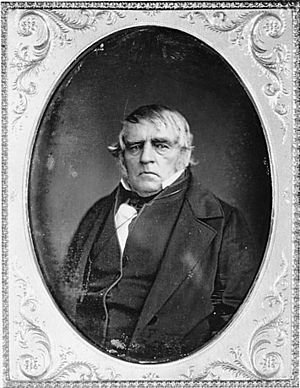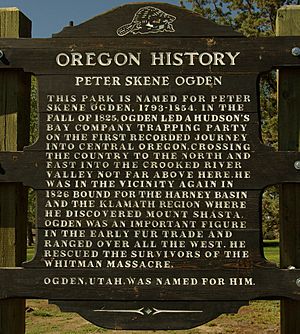Peter Skene Ogden facts for kids
Quick facts for kids
Peter Skene Ogden
|
|
|---|---|
 |
|
| Born | c. 1790 |
| Died | September 27, 1854 (aged 63–64) Oregon City, Oregon, United States
|
| Resting place | Mountain View Cemetery, Oregon City, Oregon |
| Nationality | British |
| Occupation | Fur trader, explorer |
| Employer | |
| Known for | Exploring the western United States |
Peter Skene Ogden (born around 1790 – died September 27, 1854) was a British-Canadian fur trader and an early explorer. He explored many parts of what is now British Columbia and the Western United States. His journeys took him through areas like Oregon, Washington, Nevada, California, Utah, Idaho, and Wyoming. Even though he had conflicts with the Hudson's Bay Company (HBC) at first, he later became a high-ranking official there. He managed important trading posts like Fort Simpson.
Contents
Peter Skene Ogden: Explorer and Fur Trader
Early Life and Family
Peter Skene Ogden was the son of Isaac Ogden, a Chief Justice in Quebec, and Sarah Hanson. His family had moved to the American colonies from Britain in the 1600s.
Peter's father and grandfather were Loyalists during the American Revolution. This meant they supported the British side. Isaac moved to England during the war, then returned to British-controlled Quebec. Peter's brother, Charles Richard Ogden, became a lawyer and politician. Peter Skene Ogden married Julia Rivet/Reava, who was of Metis and Nez Perce heritage.
A Life in the Fur Trade
After a short time with the American Fur Company, Ogden joined the North West Company in 1809. His first job was at Île-à-la-Crosse, Saskatchewan, in 1810. By 1814, he was in charge of a trading post at Green Lake, Saskatchewan.
Early Challenges and Company Merger
Ogden often had problems with employees from the rival Hudson's Bay Company (HBC). In 1816, HBC workers reported that Ogden was involved in a serious conflict with a Native American who had traded with the HBC. Even though some in the North West Company saw this as part of the tough life in the Northwest, the HBC saw Ogden as a dangerous person. He faced serious accusations, and the North West Company moved him further west to avoid more trouble. He worked at different posts in what is now Oregon, Washington, and British Columbia.
To end the fighting between the two companies, the HBC and the North West Company joined together in 1821. Ogden's past actions made this merger tricky. Some leaders in the new, larger HBC did not trust him. However, the new governor, George Simpson, pushed for Ogden to be allowed to stay. Simpson argued that Ogden had done nothing worse than many others during the "fur-trade wars." In 1823, Ogden was made a Chief Trader in the HBC. He was put in charge of Spokane House. In 1824, he took charge of the Snake River Country expeditions for the HBC.
Exploring the West
Between 1824 and 1830, Ogden led many expeditions to explore and trap furs in the Snake River Country. One goal was to collect as many furs as possible. This would create a "fur desert" to discourage American trappers from coming into the area.
His exploration trips included:
- 1824–25: Ogden led a group that expanded HBC's reach. They went along the Snake River east to Montana's Bitterroot River. They also went south to the Bear River in Utah. During this trip, near Mountain Green, Utah, 23 independent trappers left Ogden's group. They took about 700 beaver furs with them to join American traders.
- 1825–26: Traveling south from the Columbia River to the Deschutes River in Oregon. Ogden then turned east and traveled through the Blue Mountains to the Snake River.
- 1826–27: From Walla Walla, in Washington, an expedition explored the Deschutes River. They followed it to Klamath Lake and an area near Mount Shasta in Northern California.
- 1828–29: Ogden explored the Great Salt Lake and the Weber River area. The Ogden River and the city of Ogden, Utah are named after him. He explored parts of the Great Basin. He found and followed the Humboldt River for about 330 miles (530 km) west. This river is now named after German naturalist Alexander von Humboldt. A year earlier, in 1827, American explorer Jedediah Smith was the first American to cross the Great Basin. Smith, however, missed the Humboldt River and almost died from lack of food and water. Ogden's easier route along the river later became part of the famous California Trail.
- 1829–30: Leaving Fort Vancouver in August 1829, Ogden went to Walla Walla. Then he traveled to the Great Salt Lake, and southwest. He likely reached the Gulf of California. He then went north through California, staying away from Mexican authorities. On July 3, at The Dalles, nine men, a woman, and her two sons drowned when their boat was caught in a whirlpool. Also lost were 300 beaver furs and all the papers from the trip, including Ogden’s journal. Ogden and the other survivors reached Fort Vancouver on July 6, 1830.

Important Achievements
In 1830, Ogden was sent north to set up a new HBC post called Fort Simpson. It was near the mouth of the Nass River in British Columbia. He also managed a trading post on the south coast of Alaska. In 1834, he was promoted to Chief Factor, which was the highest field rank in the HBC. He managed Fort Vancouver in the late 1840s. There, Ogden successfully competed against American fur traders. He also made agreements with local Native American tribes, including the Cayuse. In 1847, Ogden helped prevent a larger conflict. He successfully negotiated for the release of 49 settlers who were held captive by the Cayuse and Umatilla tribes after the Whitman massacre.
Later Years and Legacy
Ogden retired to Oregon City, Oregon. He lived there with one of his several Native American wives. His experiences with Native American tribes led him to write a book called Traits of American Indian Life and Character. By a Fur Trader. The book was published after he died in 1855. He passed away in 1854 and is buried at the Mountain View Cemetery in Oregon City.
Many places are named after Peter Skene Ogden, including:
- Ogden, Utah
- Ogden, a neighborhood in Calgary, Alberta, Canada
- Ogden Avenue, a street in downtown Las Vegas, Nevada
- Ogden Point in Victoria, British Columbia, Canada
- Peter S. Ogden Elementary School in Vancouver, Washington
- Peter Skene Ogden Secondary School in 100 Mile House, British Columbia, Canada
- Peter Skene Ogden State Scenic Viewpoint in Jefferson County, Oregon
- The SS Peter Skene Ogden, a ship built in 1942. It was attacked and sunk off the coast of Algeria in 1944.
See also
 In Spanish: Peter Skene Ogden para niños
In Spanish: Peter Skene Ogden para niños

